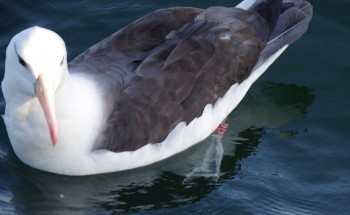José Granadeiro (Centre for Environmental and Marine Studies, University of Lisbon, Portugal.) and colleagues have published in the journal Bird Conservation International on Black-browed Albatrosses Thalassarche melanophris bathing at sea near to their colonies.
The paper’s abstract follows:
“Tracking studies of seabirds have generally focused in identifying areas used for foraging, in the hope of highlighting regions of energy transfer which may be important for seabird and general ecosystem conservation and special management. However, some sea areas may serve functions other than providing nutritional resources, which may be equally relevant, particularly if used by large numbers of individuals. In this paper, based on a study of 4 breeding colonies in the Falkland Islands and on 314 individuals tracked, we show that virtually all (97.8%) black-browed albatrosses Thalassarche melanophris (BBA) bathe in the close vicinity of the colony, remaining in the area for nearly an hour, before departing on a foraging trip. This compares with only 20 to 40% of the individuals landing close to the colony at the end of a foraging trip. The observed utilization of marine areas by BBA in a radius of 1 to 5 km around the nesting colony is one order of magnitude higher than elsewhere, including foraging hotspots. Clearly, even long-range flying birds such as albatrosses can make an intensive use of the sea-surface in the immediate vicinity of the colonies, and therefore any threats to seabirds in these areas (disturbance, pollutants, collision with artificial structures and light attraction) can potentially have a major impact at the population level. As such, the close neighbourhood of seabird colonies are potentially highly sensitive areas, and this needs to be taken into account when carrying out risk assessments or during marine spatial planning exercises.”

Blcak-browed Albatross on the sea surface, photograph by Kollette Grobler
Reference:
Granadeiro, J.P., Campioni, L. & Catry, P. 2018. Albatrosses bathe before departing on a foraging trip: implications for risk assessments and marine spatial planning. Bird Conservation International 28: 208-215.
John Cooper, ACAP Information Officer, 27 June 2018

 English
English  Français
Français  Español
Español